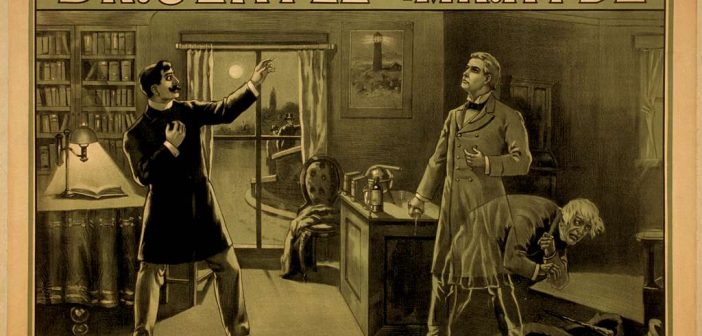There are many novels and novellas within Gothic literature that have helped to shape modern horror stories. I believe that one of the most influential has to be Robert Louis Stevenson’s 1886 novella The Strange Case of Dr. Jekyll and Mr. Hyde. This is a story that has always piqued my interest due to the Stevenson’s well-thought out plot, and how his interesting way of storytelling and characterisation can easily illicit fear alongside curiosity in his readers.
The Strange Case of Dr. Jekyll and Mr. Hyde is told from the point of view of a lawyer named Mr. Utterson, through a third-person omniscient narrator. The reader is exposed to Utterson’s discovery of his friend Dr. Jekyll’s sudden strange behaviour, as well as the disturbing arrival and appearances of Mr. Hyde. As the story progresses, Utterson decides to take on the role of detective in an attempt to uncover the secret behind Dr. Jekyll’s self-isolation and the connection that he seems to have with the vicious and cruel Mr. Hyde.
Stevenson is writing during the late Victorian era, which is the same era in which Oscar Wilde writes and publishes his own gothic novel, The Picture of Dorian Gray. This shows the impact of this era on the Gothic genre as a whole because several influential texts were written and published during this time period. In The Strange Case of Dr. Jekyll and Mr. Hyde, Stevenson utilises the character of Dr. Henry Jekyll as an embodiment of society’s views of the ideal middle-class man in his ideas about morality and how he should follow these ideals in order to prevent judgement from his peers to protect his reputation. Mr. Hyde completely counteracts this through being the embodiment of evil, and also a symbol of a man’s desire to be immoral and to commit crimes without the fear of being discovered and having his reputation damaged.
This could perhaps be seen as an idea that has spread through modern horror stories, in film and in literature. For example, the idea of shaping another identity in order to commit crimes is seen in films such as Scream in how the characters of Billy Loomis and Stu Macher dress in the Ghostface costume in order to avoid their victims and the police discovering that they are behind the brutal Woodsboro murders. Like in The Strange Case of Dr. Jekyll and Mr. Hyde, the connection of Loomis and Macher to Ghostface is made in the same way that Mr. Utterson discovers how Dr. Jekyll and Mr. Hyde are one and the same.
Victorian Gothic literature and modern horror stories share some common ideas, including the way of creating an atmosphere of fear and dread. The writers of modern horror stories take the ideas of Victorian Gothic literature and build upon this to make for an even more terrifying and bone-chilling tale. For example, Stevenson chooses to use horror imagery to create a sinister landscape for Mr. Hyde to commit his evil deeds as is seen in his description of how the dark streets of London twist and coil. This is mirrored in many other modern horror stories such as Silvia Moreno-Garcia’s Mexican Gothic (2020) and Lauren A. Forry’s Abigale Hall (2016). Both of these novels take on the idea of using a setting in the same way Stevenson does in order to create a sense of terror and intimidation for the reader, in the same way as it does for the characters within these stories.
I believe that Robert Louis Stevenson’s The Strange Case of Dr. Jekyll and Mr. Hyde is one of the most influential tale of Gothic literature in the way it has helped shape the modern horror genre in terms of a character’s use of duality in order to avoid damage to their own self as well as Stevenson’s skilful use of setting in order to intimidate both his characters and his readers. I will end by saying that Stevenson deserves his place among the likes of Oscar Wilde and Charlotte Brontë as an influential Gothic writer for these reasons.



